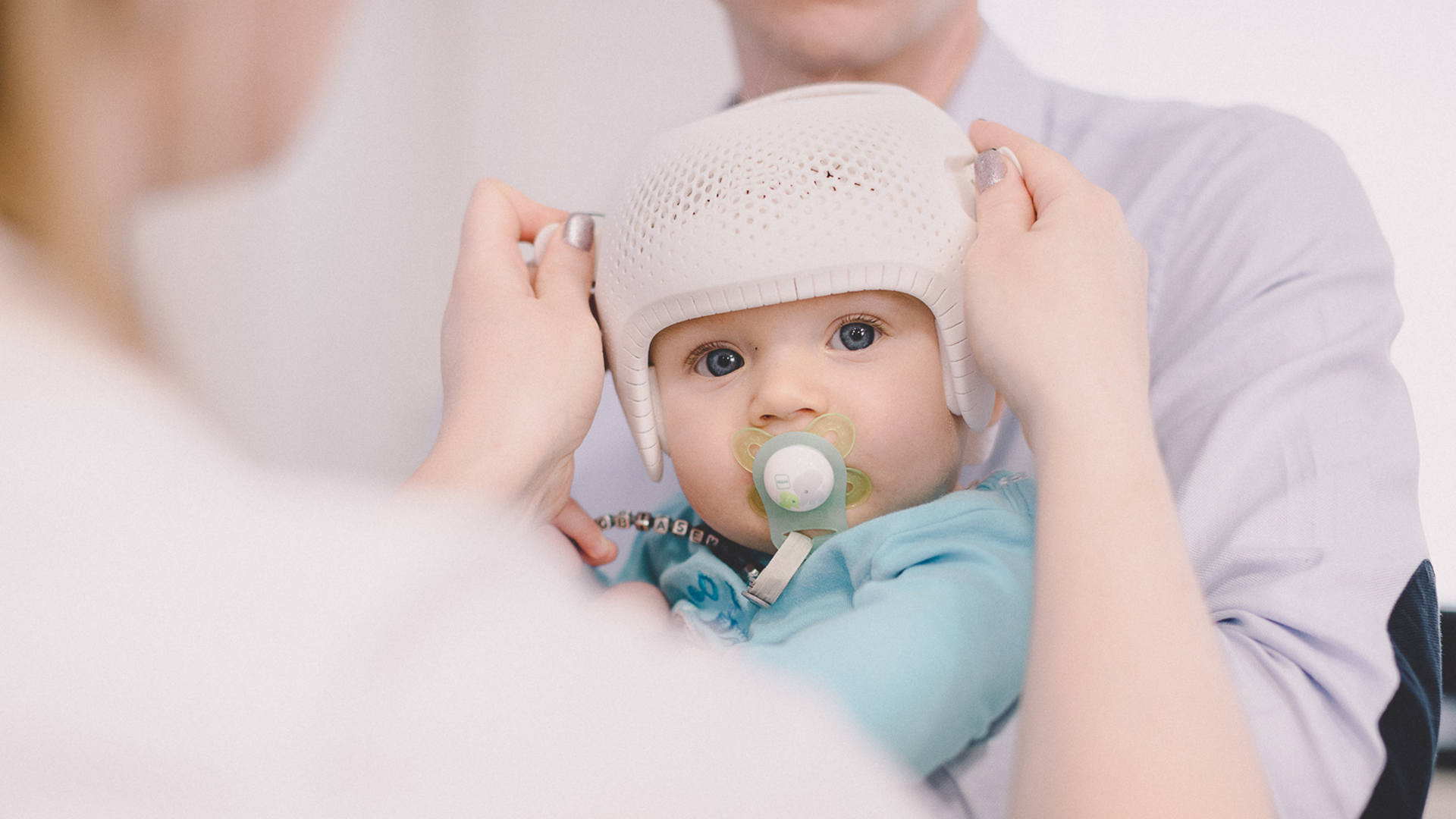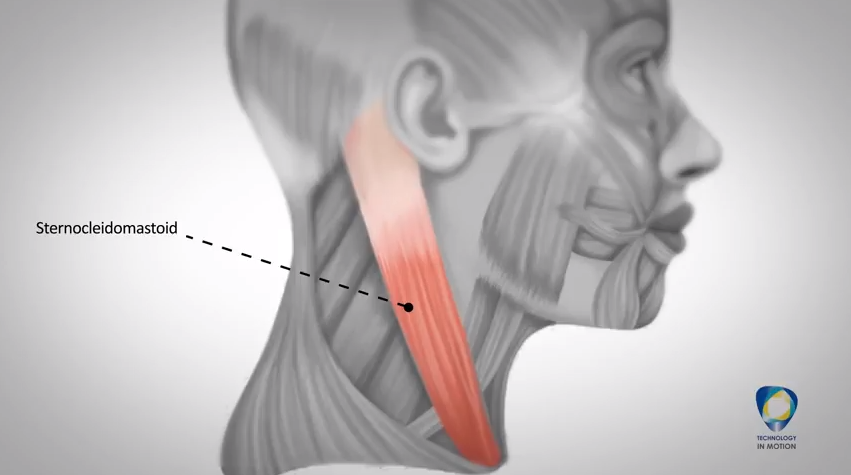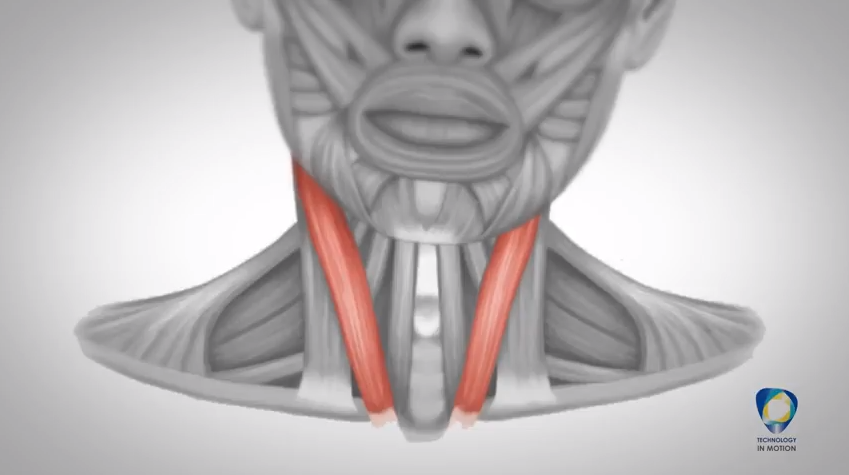
What is Plagiocephaly and Torticollis?

Plagiocephaly is the most common form of flat head syndrome and presents itself as an asymmetrical head shape, with one side of the head usually being more flat than the other side. Torticollis is a condition characterised by a head tilt to one side as a result of a shortened neck muscle. A true torticollis is the result of a small knot in the muscle fibres of one of the neck muscles, known as the sternocleidomastoid muscle (above image). This small knot of muscle fibres has a scary name, a sterncleidomastoid tumour, but this only means that the doctor can feel a lump of knotty tissues that can be eased out with stretches and manipulation.
How Does Torticollis Affect Plagiocephaly?
Babies with torticollis have limitations in neck movement from left to right, which further contributes to the tendency of keeping the head to one side. Many babies born with torticollis can therefore develop plagiocephaly as a result of this condition, as their head will spend more time in a more comfortable position.
On the other hand, babies with severe plagiocephaly will often require extra energy to turn the head to the side to which they are less accustomed to. In order to avoid discomfort, they keep the head turned to the same side as much as possible, resulting in a functional shortening of the muscles on one side of the neck. This is known as functional torticollis as there is no lump of knotty fibres in the muscles.
Treatment for Torticollis and Plagiocephaly
In the early stages, the best treatment for torticollis is to gradually encourage an increase in neck movement. To do this, regularly ease the head gently from one side to the other, only going as far as is comfortable for your baby. To help, make this into a game and you can encourage your baby to turn to the affected side by placing toys on that side. You can also encourage movement by feeding from alternating sides. For more tips, head over to our guide for 5 exercises that improve torticollis.
These techniques will help to loosen and extend your baby’s tightened neck muscle and will result in an increase in neck mobility. You will also find that physiotherapy or osteopathy from a paediatric specialist will help to improve range of movement in the neck and help with core strength and midline stability. Discover more information on how physiotherapy can help torticollis.
To help prevent and improve both torticollis and plagiocephaly, repositioning techniques can enable your baby to improve their strength and prevent one area of the head from being leaned on continuously. Encourage your baby to play on their front during supervised tummy time, use a carry sling, and balance your baby on your knee without allowing them to rest their head on you.
If these techniques have failed to make a difference in the head shape by the time your baby is around five months old, it is important that you consult a specialist as soon as possible in order to avoid permanent deformation. Technology in Motion provides the unique TiMbandAir treatment in its clinics across the UK. They have corrected thousands of babies’ head shapes to date. Call 0113 218 8030 for more information, and an expert will be happy to answer your questions.
Plagiocephaly is the most common form of flat head syndrome and presents itself as an asymmetrical head shape, with one side of the head usually being more flat than the other side. Torticollis is a condition characterised by a head tilt to one side as a result of a shortened neck muscle. A true torticollis is the result of a small knot in the muscle fibres of one of the neck muscles, known as the sternocleidomastoid muscle (above image). This small knot of muscle fibres has a scary name, a sterncleidomastoid tumour, but this only means that the doctor can feel a lump of knotty tissues that can be eased out with stretches and manipulation.
How Does Torticollis Affect Plagiocephaly?

Babies with torticollis have limitations in neck movement from left to right, which further contributes to the tendency of keeping the head to one side. Many babies born with torticollis can therefore develop plagiocephaly as a result of this condition, as their head will spend more time in a more comfortable position.
On the other hand, babies with severe plagiocephaly will often require extra energy to turn the head to the side to which they are less accustomed to. In order to avoid discomfort, they keep the head turned to the same side as much as possible, resulting in a functional shortening of the muscles on one side of the neck. This is known as functional torticollis as there is no lump of knotty fibres in the muscles.
Treatment for Torticollis and Plagiocephaly
In the early stages, the best treatment for torticollis is to gradually encourage an increase in neck movement. To do this, regularly ease the head gently from one side to the other, only going as far as is comfortable for your baby. To help, make this into a game and you can encourage your baby to turn to the affected side by placing toys on that side. You can also encourage movement by feeding from alternating sides. For more tips, head over to our guide for 5 exercises that improve torticollis.
These techniques will help to loosen and extend your baby’s tightened neck muscle and will result in an increase in neck mobility. You will also find that physiotherapy or osteopathy from a paediatric specialist will help to improve range of movement in the neck and help with core strength and midline stability. For more information on how physiotherapy can help torticollis read our blog.
To help prevent and improve both torticollis and plagiocephaly, repositioning techniques can enable your baby to improve their strength and prevent one area of the head from being leaned on continuously. Encourage your baby to play on their front during supervised tummy time, use a carry sling, and balance your baby on your knee without allowing them to rest their head on you.
If these techniques have failed to make a difference in the head shape by the time your baby is around five months old, it is important that you consult a specialist as soon as possible in order to avoid permanent deformation. We provide the unique TiMbandAir treatment in its clinics across the UK. They have corrected thousands of babies’ head shapes to date. Call 0113 218 8030 for more information, and an expert will be happy to answer your questions.
Babies with torticollis have limitations in neck movement from left to right, which further contributes to the tendency of keeping the head to one side. Many babies born with torticollis can therefore develop plagiocephaly as a result of this condition, as their head will spend more time in a more comfortable position.
On the other hand, babies with severe plagiocephaly will often require extra energy to turn the head to the side to which they are less accustomed to. In order to avoid discomfort, they keep the head turned to the same side as much as possible, resulting in a functional shortening of the muscles on one side of the neck. This is known as functional torticollis as there is no lump of knotty fibres in the muscles.
Treatment for Torticollis and Plagiocephaly
In the early stages, the best treatment for torticollis is to gradually encourage an increase in neck movement. To do this, regularly ease the head gently from one side to the other, only going as far as is comfortable for your baby. To help, make this into a game and you can encourage your baby to turn to the affected side by placing toys on that side. You can also encourage movement by feeding from alternating sides. For more tips, head over to our guide for 5 exercises that improve torticollis.
These techniques will help to loosen and extend your baby’s tightened neck muscle and will result in an increase in neck mobility. You will also find that physiotherapy or osteopathy from a paediatric specialist will help to improve range of movement in the neck and help with core strength and midline stability. Explore how physiotherapy can help torticollis.
To help prevent and improve both torticollis and plagiocephaly, repositioning techniques can enable your baby to improve their strength and prevent one area of the head from being leaned on continuously. Encourage your baby to play on their front during supervised tummy time, use a carry sling, and balance your baby on your knee without allowing them to rest their head on you.
If these techniques have failed to make a difference in the head shape by the time your baby is around five months old, it is important that you consult a specialist as soon as possible in order to avoid permanent deformation. Technology in Motion provides the unique TiMbandAir treatment in its clinics across the UK. They have corrected thousands of babies’ head shapes to date. Call 0113 218 8030 for more information, and an expert will be happy to answer your questions.


